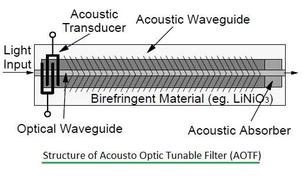ROADM Types: WB vs PLC vs WSS vs WXC
Advertisement
This page compares different types of ROADMs: WB, PLC, WSS, and WXC. It highlights the differences between WB (Wavelength Blocker), PLC (Planar Lightwave Circuit), WSS (Wavelength Selective Switch), and WXC (Wavelength Crossconnect) ROADM types. ROADM stands for Reconfigurable Optical Add Drop Multiplexer. All the ROADM types mentioned here are used as reconfigurable add/drop multiplexers in the fiber optic domain.
WB-Wavelength Blocker ROADM

Figure-1 depicts configuration of WB ROADM type.
PLC-Planar Lightwave Circuit ROADM

Figure-2 depicts configuration of PLC ROADM type.
WSS-Wavelength Selective Switch ROADM

Figure-3 depicts configuration of WSS ROADM type.
WXC-Wavelength Crossconnect ROADM

Figure-4 depicts configuration of WXC ROADM type.
Comparison Table of ROADM Types
The following table summarizes the differences between the ROADM types discussed above.
| Comparison Factor | WB ROADM | PLC ROADM | WSS ROADM | WXC ROADM |
|---|---|---|---|---|
| Full Form | Wavelength Blocker | Planar Lightwave Circuit | Wavelength Selective Switch | Wavelength Crossconnect |
| Configuration | 2 DWDM ports e.g. 1 IN and 1 OUT | 2 DWDM ports e.g. 1 IN, 1 OUT and 2*N single λ ports | N+1 DWDM ports e.g. 1 IN, 1 OUT and N-1 service | 2*N DWDM ports e.g. N-1 IN, N-1 OUT, 1 ADD and 1 DROP |
| Sub-system | LCD WB | PLC | small switch array and AWGs (Arrayed Waveguide Grating) | 1 x N MEMS WSS, 1 x N LCD WSS, 1 x N LCoS WSS PLC Matrix Switches and AWGs |
| Advantages (Pros) | It is first ROADM developed, Number of A/D ports = N (All λ’s) | • low power consumption • Lowest cost • No moving parts • No vibration sensitivity | • Can be mesh upgradable • Can be colorless • Lowest cost for degree 5 to 8 | • Upgradable to any degree as per internal architecture • Any multiple λ’s between any two ports |
| Disadvantages (Cons) | • Not mesh upgradable • Supports DCE function only | • extra optical devices such as splitters, combiners, taps are needed for A/D • Not easily upgradable to Degree-2, • Not easily colorless | • Vibration sensitive • Not cost effective for degree-2 version • Number of A/D ports are less than N and not λ upgradable | Costly if non PLC switches, MUX, De-mux are used. |
Advertisement
 RF
RF



